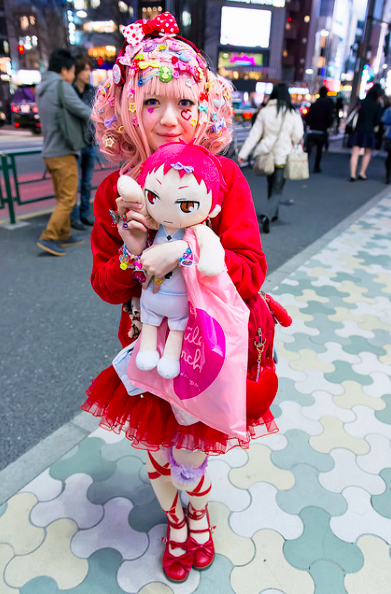Japanese Youth Culture is very unique and has became very popular since its rise in the 1980's. No where else in the world has any youth culture like this and in Japan it is considered to be whats called 'Angura' which means it is its own culture. Within this extraordinary country, rather than just one type of culture, it has many different groups that are called tribes, that are based on certain type's of looks. Many copy and look like popular subjects such as anime and musical inclination. The images below show how the Japanese youths dress very bright, colourful and is clearly very experimental. The main aim in most cases, is to be 'Kawaii' meaning cute and the distinct rejection to grow up and become more mature is the way teenagers in Japan are that has remained a key element in how they look. The beloved Kawaii trend has not just been apart of fashion, but because of the obsession with it, now is seen on products like handbags, household objects, cars and even planes, which is also apparent across the world with brands such as Hello Kitty being hugely popular in almost every country. There are many subcultures that are all very different but most still carry cuteness. Groups such as Decora, Lolita, Kawai, Ganguro, Visual Kei, Cosplay and Shironri each have their own different style and would be clear to see when in Japan and some being more gothic than others. If you are in a Japanese Youth Culture, the place to be seen in Harajuku, which is known as an international centre for the subcultures and other fashion interests. It is a huge community for shopping and eating. The main area to be for the youth culture is Yoyogi Park, where you can see other people with similar dress sense and those who are different. It commonly observes Harajuku fashion walks, which can be considered a competition to show off what you are wearing. Another popular area within the Youth Cultures is Akihabara or known as 'Electric Town' because of it being a main shopping town for electronic items, but is a popular place for video games and anime. Anime and Manga have created cosplay in Japan, which is when youth cultures dress up as their favourite characters in these animations. Music stars also copy their look off these comics and cartoons so their image will jump out at their audience. The music is not the only most important factor in their careers, but appearance is the next main influence, that can often be confusing for an outsider, because gender is not always clear to see. Ambiguity is not relevant in Japan because the beauty of these young men overstep's any reason for why they should not show it off, which hair and makeup does, that creates a presence and 'look' that will be remembered by their audience. Overall Japanese youth culture is massively popular and over the years has gradually became more common in Western countries, that can be scene even in the music business with artists like Katy Perry and Marilyn Manson, which shows the freedom in dress sense has made the world interested and amazed by these youth cultures.





Image's taken from: https://www.flickr.com/photos/tokyofashion/




